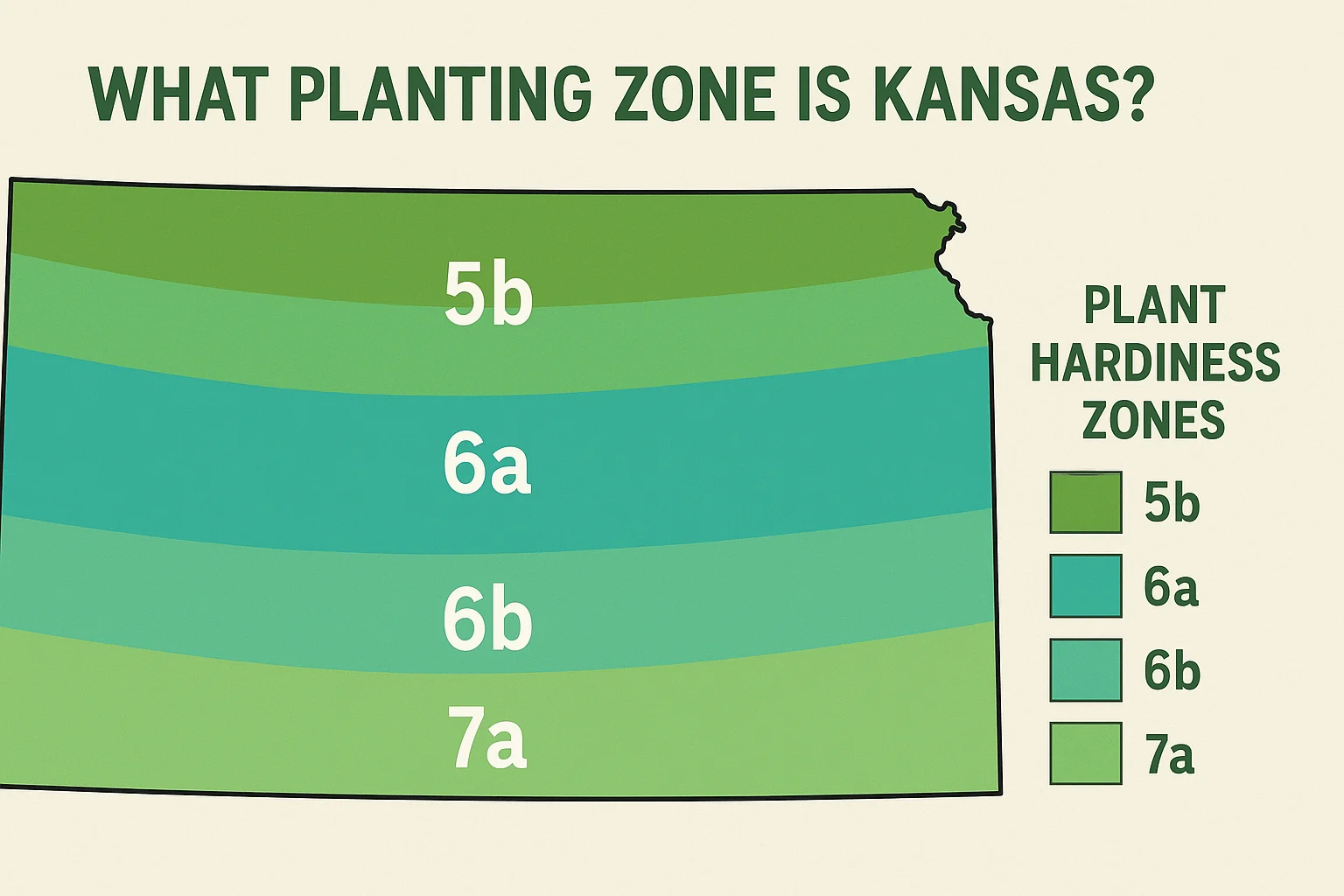What Planting Zone is Kansas?[Map, Cities, and Growing Tips]

If you’re planning to grow a garden or landscape your yard in the Sunflower State, the first question you should be asking is: What planting zone is Kansas? This simple classification can make or break your gardening success by helping you select plants that thrive in your region.
In this guide, we’ll cover the exact planting zones in Kansas, show how they vary across the state, and explain why understanding your zone is essential for gardeners and growers alike.
What Planting Zone is Kansas?
Kansas spans USDA Plant Hardiness Zones 5b to 7a. Here’s a breakdown:
| Region | USDA Zone |
|---|---|
| Northern Kansas (e.g., Hiawatha, Marysville) | Zone 5b |
| Central Kansas (e.g., Salina, Great Bend) | Zone 6a |
| Southern Kansas (e.g., Wichita, Arkansas City) | Zone 7a |
When someone asks “What planting zone is Kansas?”, the most accurate answer depends on where you are in the state. Kansas covers a wide latitudinal range, so northern areas experience colder winters (Zone 5b), while southern cities enjoy a warmer Zone 7a climate.
📍 Kansas Planting Zones by Major Cities
For a more specific answer to what planting zone is Kansas, here’s a city-level overview:
| City | Planting Zone |
|---|---|
| Kansas City | Zone 6a |
| Wichita | Zone 7a |
| Topeka | Zone 6a |
| Salina | Zone 6a |
| Manhattan | Zone 6a |
| Dodge City | Zone 6b |
| Hays | Zone 6a |
| Garden City | Zone 6a |
Understanding what planting zone is Kansas for your specific location helps you select plants suited to your local climate, especially perennials and cold-sensitive crops.
🌡️ Why Does the Planting Zone Matter in Kansas?
The question “What planting zone is Kansas?” isn’t just for trivia. It directly impacts:
- Perennial survival in winter
- Frost dates for planting schedules
- Plant hardiness for shrubs, trees, and flowers
For instance, a plant rated for Zone 7a might thrive in southern Kansas but could struggle to survive the colder winters in Zone 5b.
🧠 Example: Tomatoes in Kansas Zones
In Zone 5b (northern Kansas), outdoor tomato planting typically begins after the last frost in mid-May. In Zone 7a (southern Kansas), you might safely plant tomatoes as early as mid-April.
This distinction affects:
- Growing season length
- Harvest potential
- Risk of frost damage
Understanding what planting zone is Kansas helps gardeners plan for these crucial differences.
📅 Kansas Planting Calendar by Zone
| Crop Type | Zone 5b Start | Zone 6a Start | Zone 7a Start |
|---|---|---|---|
| Cool-season crops (lettuce, peas) | March | February | January-February |
| Warm-season crops (tomatoes, peppers) | Mid-May | Late April | Mid-April |
| Perennials & Shrubs | Fall planting or early spring | Same | Same |
💡 Gardening Tips for Kansas Climate
Kansas has a continental climate with hot summers, cold winters, and sometimes unpredictable weather. Here’s how to work with it:
✅ Do:
- Mulch heavily to retain moisture and regulate soil temperature
- Select drought-tolerant plants for hot summers
- Use windbreaks in open plains regions
- Amend heavy clay soils with compost
❌ Avoid:
- Planting tender perennials too early in spring
- Neglecting shade during summer heatwaves
- Overwatering in early spring when soils are still cool
These tips apply no matter which part of Kansas you’re in, but knowing what planting zone is Kansas where you live helps fine-tune your approach.
🗺️ Find Your Exact Kansas Planting Zone
To pinpoint what planting zone is Kansas for your exact zip code, use the official USDA Plant Hardiness Zone Map. This tool will give you the most precise zone based on your location’s historical temperature data.
🧮 Recommended Gardening Tools for Kansas Growers
Take advantage of these calculators to optimize your garden:
- Soil Volume Calculator – Know exactly how much soil you need for raised beds.
- Plant Spacing Calculator – Prevent overcrowding and maximize yield.
- Indoor Plant Watering Calculator – Perfect for your houseplants or container garden.
🙋 FAQs About Kansas Planting Zones
What is the coldest planting zone in Kansas?
Northern Kansas falls into Zone 5b, with average winter lows reaching -15°F to -10°F.
Can you grow peaches in Kansas?
Yes, but primarily in Zones 6a and 7a. Late frosts in Zone 5b can damage blossoms.
When is the last frost date in Kansas?
- Zone 5b: Mid-May
- Zone 6a: Late April
- Zone 7a: Mid-April
✅ Conclusion: Why Knowing the Kansas Planting Zone Matters
Whether you’re growing tomatoes, planting a pollinator garden, or establishing a new landscape, knowing what planting zone is Kansas is essential. With zones ranging from 5b to 7a, your planting zone determines:
- What plants will survive winter
- When you should start planting
- How to adjust your gardening practices for success
Before you plant, check your zone — and choose plants that are built for Kansas.
